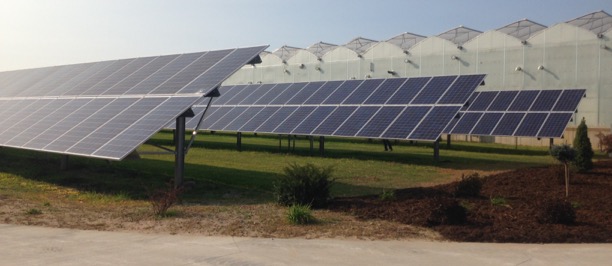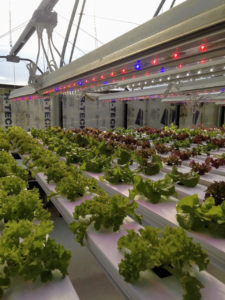
Minimizing Greenhouse Energy Loss
Solar power, also known as photovoltaic (PV) systems, LED lights (light-emitting diode) and infrared heaters are all some of the technologies being looked at as ways to reduce greenhouse energy costs, whether it is for growing CEA crops or floriculture crops. But the first step in any investment is to reduce any existing energy inefficiencies in your greenhouse.
 That’s the message from Heidi Lindberg, Michigan State University (MSU) greenhouse and nursery educator. Lindberg offers these tips on improving energy efficiency.
That’s the message from Heidi Lindberg, Michigan State University (MSU) greenhouse and nursery educator. Lindberg offers these tips on improving energy efficiency.
Manage the temperature based on the crop and finish date. “Do I grow the crop cooler for a longer period of time or warmer for a shorter period of time? It saves energy to grow at a warmer temperature for a shorter time,” Lindberg says.
Close air leaks. Seal vents, doors and fan openings with weather stripping, and cover exhaust fan openings when not in use. Fix any tears in the poly and replace any cracked or missing glass panes. “Close up those leaky spots in the greenhouse,” Lindberg says. “You don’t want energy savings to go out of the door or out of the poly.”
Horizontal air flow fans help mix the air in the greenhouse and can help keep temperatures uniform. The fans also mix the humidity and CO2. Consistent air temperature throughout the crop will ensure the crop grows as uniformly as possible.
Install infrared (IR), anti-condensate poly film. The IR film treatment lets sunlight in but traps the radiant heat inside the greenhouse. The anti-condensate treatment reduces the surface tension on the poly allowing condensation to flow down the poly and not form droplets. “You don’t have as many drops of condensation on the underside of the poly,” Lindberg remarks. The droplets can block sunlight, drip on plants and workers, create an environment conducive for pathogens and create safety issues such as slippery algae on the floor.
Use photoperiodic lighting on long-day plants. Long-day plants flower when the dark hours fall below their critical photoperiod. Properly timed supplemental lighting can artificially reduce the number of nighttime hours. “You use photoperiodic lighting to induce flowering,” Lindberg says. “The goal is to grow a quality plant as fast as you can.”
Incandescent lamps alternating with compact fluorescent lamps are effective for stimulating flowering of long-day plants. LED lights can also be used to regulate flowering by photoperiodic lighting, but choose the LED lights carefully. LED lights are a major investment and there are many LED lamps available. Their light spectrum varies and sometimes causes confusion on how to use them. You need to be careful about what you’re using, Lindberg says, and check out some of the resources that are available.
Use high-intensity light on young plants. “High-intensity lights are most economical for growing young plants because you have so many plants per square foot,” Lindberg says.
Transplant larger plugs and liners. Plants in larger plug trays take less time to finish growth, but larger plugs do cost more.
Use more energy-efficient heaters. Some heat is always lost with the exhaust gases, but more energy efficient heaters lose less. “The most efficient heaters for greenhouses have up to 96% thermal efficiency,” Lindberg says.
Insulate side, knee and end walls. Whenever the temperature in the greenhouse is different than the outside air, heat energy will move through the structure materials from the warm side to the cool side.
Install retractable energy curtains. The curtains shade the crop on sunny days in the spring and summer and keep heat in the greenhouse at night during the winter. “Installing energy curtains isn’t going to be profitable in every situation,” Lindberg states. If you start growing in March, you’re probably not going to need one. “If you’re growing in the winter to get plants to market in March, they are very cost effective.”
Install more energy efficient lamps. LED lamps continue to improve and lamps with a photosynthetic photon efficacy (μmol×J–1) of greater than two are available. Make sure to ask about that efficacy number prior to purchasing lamps.
Install in-floor heat to increase substrate temperature and to decrease air temperature. “You can lower your air temperature and increase your substrate temperature if you have root zone heating,” Lindberg says.
Use environmental control systems. They’re more responsive and growers don’t have to manually alter the environment several times a day.
For growers who want to consider solar, consider getting an energy audit to assess your system. “That’s where you want to start,” says Charles Gould, MSU agricultural bioenergy and energy conservation educator.
Most public utilities and electric cooperatives offer free energy audits, but they are not the type 2 audits such as the ones offered through MSU’s Michigan Farm Energy Program (MFEP). The MFEP has energy auditors trained in agriculture and floriculture. “They are familiar with [our] business and how you grow plants,” Gould says.
The American Society of Heating, Refrigeration and Air-Conditioning Engineers defines three levels of energy audits — types 1, 2 and 3 — with the larger numbers having greater detail and accuracy.
Type 2 audits are required to participate in the Natural Resources Conservation Service (NRCS) Environmental Quality Incentives Program (EQIP) and the USDA Rural Development’s Rural Energy for America Program (REAP).
EQIP provides funding up to 75% of the cost of eligible projects that increase energy efficiency. REAP provides grants up to 25% of the total eligible project cost and loan guarantees for up to 75% of the total eligible project cost to purchase or install renewable energy systems or make energy efficiency improvements.
The Database of State Incentives for Renewables and Efficiency at www. dsireusa.org provides a list of renewable energy incentives and policies that can be filtered by location, technology and sector. “Now is a good time to get into a renewable energy,” Gould says.


 Video Library
Video Library 




















